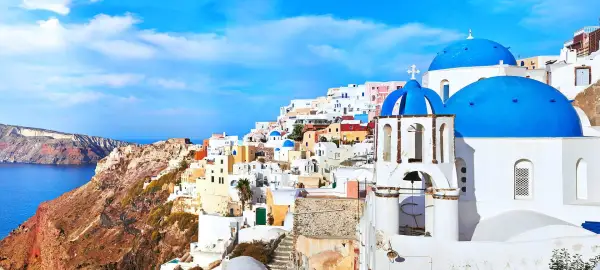Tourcode: GR17
- Overview
- Info & Inclusions
- Itinerary
- Map & Hotels
- Photos
- Dates & Prices
- Max Group Size 18
- Explore Nafplio's Venetian fortress and historic harbour
- Visit ancient Sparta and imagine the lives of the Spartans
- Walk in the footsteps of ancient athletes at Olympia
- Marvel at the ancient monasteries of Meteora
- Ascend the Acropolis and explore the Acropolis Museum in Athens
- Experience the vibrant island life of Naxos, Paros, Mykonos, Amorgos, and Santorini.
- Singles friendly (view options for single travellers)
- MealsSavour authentic flavours with included daily breakfasts and dinners at handpicked local restaurants—immersing you in local cuisine without worrying about reservations or budgets.
- Transport & Logistics
Private air-conditioned coaches and included internal ferries and flights—ensuring hassle-free travel so you can focus entirely on the discoveries ahead.
"Adventures Abroad tour leader's management and guest services managed the tour with great skill and dedication. The tour leader was on top of every move and transfer. We have not experienced any issues with logistics and had a great time."
~ JULIA O"The tour leader did an excellent job coordinating some difficult travel logistics, power outage issues and resolving problems and dealing with guests who had unrealistic expectations."
~ CYNTHIA COLLINS - Expert Guidance
Unlock insider secrets at every landmark with your full-time Tour Leader and expert local guides , all gratuities covered—no hidden tipping surprises—so you immerse fully in your destination's stories, worry-free. (Except for the tips to your tour leader at the end of your tour.)
"Amazing tour guide. Our tour guide was very well organized, Her passion, knowledge, and enthusiasm completely transformed the travel experience into something truly unforgettable..."
~ MELANIE LEMAIRE"Highly recommend every trip with Adventures Abroad. It's a well organized and well thought out adventure. The tour leaders are friendly, knowledgeable and experienced professionals. Highly recommend this company."
~ SUSAN WALL - Sightseeing & EntrancesAll entrance fees for sites visited as per the itinerary—no hidden costs—so you can explore ancient ruins and excursions with complete peace of mind.
- AccommodationsUnwind in clean, well-located 3 to 4-star hotels with private en suite facilities—handpicked for comfort and convenience after each day's discoveries—so you can rest easy knowing your stay supports the real adventure, not steals the spotlight.
- Small Group
Discover the world in small groups of up to 18 travellers plus your expert Tour Leader—unlocking spontaneity, off-the-beaten-path adventures, and genuine connections at a relaxed pace, free from crowds.
"Looking Forward to My Next Adventure The best feature of the Adventures tour was the small size that allowed the group to quickly load up, let everyone get acquainted within the first 24 hours, capitalize on unplanned surprises along..."
~ PHILIP BLENSKI"Good value for a great time I have traveled with Adventures Abroad for over 20 years now. Well thought out, interesting itineraries and the other travelers congenial and friendly. The price always seems fair and overall a..."
~ Trusted Customer - Airport Transfers For Land & Air CustomersWe handle hassle-free airport transfers for all our land and air tour customers—plus early arrivals or late departures when you book extra hotel nights directly with us for added peace of mind.
- International airfare to/from the tour.
- Tour Leader gratuities, lunches, drinks, personal items (phone, laundry, etc), international (if applicable) air taxes, and excursions referenced as ‘optional’.
- Airport transfers for Land Only customers.
- Optional travel insurance (please refer to the 'Resources' tab)
- Seasonality and Weather:
Our spring date is planned to avoid the busier and expensive high summer high season (July/August) during which ferries can be crammed and some sites can be overcrowded (especially in Athens). May/June is a gorgeous time in terms of the landscape, which after winter rains is lush and green and festooned with wildflowers. The sea is swim-able (but still a bit chilly), and showers, though unlikely, are still possible. Another nice thing about springtime in Greece is the local people are well-rested after a long winter and especially delighted to see us!
Late summer (September) is generally warmer and one can still expect some heat, especially in Athens and elsewhere depending on proximity to water. Though the landscape has largely shed the lush greenness of spring, the true delight is the local farm produce ready for harvest at this time, all of which makes it's way into local dishes. It's also the time of the olive and grape harvest, which we may be able to witness. - Transport and Travel Conditions:
This is not a cruise! We travel to/between islands via local ferries, which can range from hydrofoils to large vehicle carrying vessels. Uncontrollable factors such as weather may result in delays & Greek ferry schedules tend to change without notice; some itinerary adjustments may be necessary with late notice.
Land transport (for the mainland, city & island tours, port transfers) by private air-conditioned coaches, minibuses and vans, depending on group size (see 'group size'). Locally we may make short hops using multiple local taxis.
Porter service is rarely available on the islands (see 'inclusions'); you MUST be independent with your luggage, especially getting on/off ferries and at hotels.
This trip is typical of most of our European tours, which are ambitious and involve full days of travel and sightseeing. While we don't have any actual strenuous activity (ie hiking) built into the program, you will do a lot of walking on this trip, mostly be in the form of walking tours of towns and cities and short walks to dinner. Being Europe, and a hilly/mountainous area, cobbles, uneven surfaces, and slopes/stairs are common. If you are accustomed to typical "bus tours," which rely heavily on vehicular transport for all sightseeing activities, you should be aware that this tour is considerably more active.
This program also has a strong gastronomic element, well-suited to "foodies," expert or novice, and those who enjoy savouring and lingering over a meal and sampling new things. While vegetarians are well catered for, we regret that very specific or extremely limited dietary restrictions/preferences may present a challenge on this trip.
Am I suitable for this tour? Please refer to our self-assessment form - Activity Level: 2
These are particularly busy tours that feature a lot of moving around, sometimes by train and short journeys on local transport. Walking tours of towns and cities are leisurely but you should be prepared to be on your feet for several hours. Some of our cultural trips that occur at high altitude and/or require greater independence with baggage handling (at hotels, airports, train stations) also fall into this category.
To learn more about the Activity levels, please visit our tour styles page. - Accommodation:
Well-located, air- conditioned, mid-range hotels (3-4 star) throughout.
Island hotels are smaller properties (3-4 story) that will likely not have elevators. All hotels have en suite bath, though most have shower only.
A special note about Santorini, which is primarily a luxury tourism destination and, while we can confidently promise our visit will be fulfilling and rewarding, one's hotel expectations must be in line with our overall purpose, which is sightseeing and cultural experience and not focused on the "hotel experience" per se.
Single rooms are limited and likely smaller than twins. - Staff and Support:
Tour Leader throughout, driver (s), local step-on local guides in various locales. - Group Size:
Maximum 18 plus Tour Leader
- Day 1:Arrival in AthensThis vibrant metropolis pulses with 5,000 years of history, from its Neolithic origins to its golden age when Athenian values shaped Western civilization. In 1834, Athens became the capital of modern Greece, transforming into an attractive metropolis that seamlessly blends archaeological treasures with contemporary European energy.
Tonight we gather with fellow travellers for our first evening meal, beginning our shared journey through the cradle of democracy and philosophy.
Overnight in Athens.
Included Meal(s): Dinner, if required - Day 2:Athens - Mycenae & Epidaurus - Nafplio (Nauplia)This morning we board our coach toward Mycenae, where massive stone fortifications crown a triangular hilltop between two dramatic gorges. Here stood the most powerful kingdom in Greece for 400 years (1600-1200 BC), its rulers building with enormous unworked stones in a style that awed even the ancient Greeks.
We enter through the famous Lion Gate, constructed in the 13th century BC, and explore the Great Court where legend claims Agamemnon met his tragic end. The Mycenaeans' mastery of this cyclopean architecture influenced fortifications across the ancient world.
Next we travel to Epidaurus, sanctuary of Asklepios, the healing god. These ancient "health farms" combined medicine with worship, drawing pilgrims seeking cures from across the Mediterranean. This prestigious centre flourished in the Classical period, receiving splendid 4th-century BC buildings. Epidaurus gained prominence when Athens adopted the cult in 420 BC, with tragedian Sophocles serving as its priest.
We then continue toward the charming seaside town of Nafplio.
Overnight in Nafplio
Included Meal(s): Breakfast and Dinner - Day 3:Naflplio - Mystra - SpartaThis morning we explore charming Nafplio's seaside character before embarking on a dramatic winding mountain drive toward Sparta.
We visit Sparta's unique Museum of the Olive and Greek Olive Oil, highlighting the culture and technology that remains inextricably linked with Greek and Mediterranean identity. Located in the heart of Laconia, one of Greece's premier olive-producing regions, this museum celebrates the liquid gold that has sustained civilizations for millennia.
We then continue to Mystra, an impregnable fortress built by Guillaume de Villehardouin in 1249. When Byzantines reclaimed the Morea from the Franks, Emperor Michael VIII Palaeologus made Mystra his capital, drawing refugees from the surrounding plains seeking protection from invading Slavs.
During the despots' rule, while the Byzantine empire crumbled elsewhere, Mystra experienced a remarkable renaissance. The city thrived under Venetian rule with 40,000 inhabitants and a flourishing silk industry, only to face repeated destruction by Russians (1770), Albanians (1780), and Ibrahim Pasha (1825). Since the 1950s, extensive restoration has revealed its former glory.
Back in Sparta, those interested may visit the archaeological remains of ancient Sparta, including the 2nd-century BC theatre - the site's most discernible ruin.
Overnight in Sparta
Included Meal(s): Breakfast and Dinner - Day 4:Sparta - Olympia: Site TourToday we travel to Olympia, arriving in the early afternoon for an extraordinary encounter with antiquity's greatest sporting spectacle.
After lunch we tour ancient Olympia, where rival Greek states laid down their weapons and gathered in sacred peace to honour the gods through athletic competition. The Temple of Zeus once dominated this complex, housing the 13-metre (43-foot) gold and ivory statue considered one of the Seven Wonders of the Ancient World.
We explore the Stadium where ancient athletes competed, and the Temple of Hera - the site's most intact structure and oldest building. Originally dedicated to both Zeus and Hera, this temple evolved from wood to stone construction, its mud-brick walls supporting a traditional tiled roof.
The Olympic Games represented the most prestigious athletic event in Greece, held in conjunction with festivals honouring Olympian Zeus. Three heralds announced dates to all Greek states, declaring universal truces that suspended hostilities. These sacred competitions ended in AD 393 when Emperor Theodosius banned all pagan festivals, with the temples destroyed in AD 426.
Overnight in Olympia
Included Meal(s): Breakfast and Dinner - Day 5:Olympia - Delphi TouringWe drive across the impressive Rio-Antirrio Bridge en route to Delphi, arriving in the early afternoon for a guided tour of this spectacular archaeological site and its excellent museum.
Nestled dramatically on Mount Parnassus's slopes, Delphi was far more than a geographical location to ancient Greeks - it was the "navel of the world." Zeus released two eagles from opposite ends of the earth, and their convergence here symbolized Delphi's central cosmic importance.
Initially revered by deities like Earth goddess Gaia, Themis (justice), Demeter (agriculture), and Poseidon (sea), this sacred site eventually became synonymous with Apollo after he slayed the serpent Python who guarded the oracle. This marked a shift toward reason, order, and the pursuit of excellence.
The Delphic Oracle wielded enormous influence throughout the Greek world. Here, the Pythia delivered prophetic pronouncements believed inspired by Apollo himself. These enigmatic utterances influenced political decisions, personal choices, and even colonial foundations.
Beyond prophecy, Delphi hosted the Pythian Games, a Pan-Hellenic festival predating the Olympics that celebrated athletic prowess and artistic expression, fostering unity among competing city-states.
Overnight in Delphi
Included Meal(s): Breakfast and Dinner - Day 6:Delphi - Kalambaka & the Monasteries of MeteoraToday we drive across central Greece's fertile plains, witnessing a landscape that testifies to the region's agricultural bounty. As we journey northward, rolling hills give way to increasingly rugged terrain, culminating in the awe-inspiring sight of Meteora's monolithic rock formations rising dramatically from the plain.
Later this afternoon, we embark on a panoramic drive around these "Rocks of the Air," marvelling at the sheer audacity of medieval monks who chose to build their monasteries atop these precarious peaks. The afternoon light casts golden hues across this extraordinary landscape, creating magical photographic opportunities that capture one of Greece's most breathtaking sights.
PLEASE NOTE: Depending on timing and logistical considerations, we may accomplish some monastery visits today and tomorrow morning. Your Tour Leader will advise in advance. Men must wear long trousers for monastery visits, while women must wear long wraps or skirts - available for purchase at sites for just a few euros.
Overnight in Kalambaka
Included Meal(s): Breakfast and Dinner - Day 7:The Monasteries of Meteora - AthensToday we delve deeper into Meteora's mystique. This extraordinary complex, second only to Mount Athos in Eastern Orthodox importance, represents human ingenuity and unwavering faith. Perched precariously atop towering sandstone pillars, these monasteries offer breathtaking spectacles against the Thessalian plain's backdrop.
Due to periodic closures, we explore monasteries not visited yesterday, allowing nuanced understanding of this unique monastic community. We wander through ancient cloisters, admire Byzantine frescoes, and perhaps glimpse monks who continue inhabiting these sacred spaces.
Later, we journey toward Athens, stopping at Thermopylae - a site forever etched in Greek legend and history. Here, at this narrow mountain pass, King Leonidas and his 300 Spartans made their heroic last stand against Xerxes' overwhelming Persian army in 480 BC. This poignant stop serves as a powerful reminder of courage, sacrifice, and the unwavering human spirit of resistance.
This historic battlefield, where "the few" faced "the many," represents one of history's most celebrated examples of valor against impossible odds, inspiring generations with its message of duty and honour.
Overnight in Athens
Included Meal(s): Breakfast and Dinner - Day 8:Athens: City TouringToday we enjoy a guided tour of Athens, the heart and soul of Greece.* A large part of the town's historic centre has been converted into a 3-kilometre pedestrian zone (one of the largest in Europe), leading to the major archaeological sites, reconstructing -- to a large degree -- the ancient landscape, thus allowing us to avoid the city's horrendous traffic. As such, much/most of our tour today will be conducted ON FOOT at a leisurely pace.
We start at the Acropolis (with hopes to beat the heat/crowds), near the site of the Dionysos Theatre. Constructed in the 6th century BC, it is one of the world's oldest theatres and the place where the great works of Aeschylus, Sophocles, Euripides and Aristophanes were first performed. We will also see a more recent theatre, the Odeon of Herod Atticus from the second century AD, which is still used for concerts and performances.
Ascending to the top of the Acropolis, we will see magnificent buildings dating from the 5th century BC, the Golden Age of Athens. On the highest point on the Acropolis is the Parthenon, often considered the finest monument to Greek civilization. The temple was dedicated to Athena "Parthenos," the virgin and patron goddess of the city.
After our Acropolis tour, we'll descend by foot and enter the Ancient Agora located adjacent to the Plaka, the old town of Athens. Among the numerous sights in this archaeological park are the well-preserved Temple of Hephaistos and the landmark Roman era Tower of the Winds.
Our guided tour ends with a guided visit of the Acropolis Museum, located at the foot of the Acropolis. The museum was built to house every artifact found on the rock, from the Greek Bronze Age to Roman and Byzantine Greece; nearly 4,000 objects are exhibited over an area of 14,000 square metres. After our tour you are free to wander and explore on your own or make your way back to the hotel with your Tour Leader's assistance.
* The exact order of our sightseeing in Athens may be altered by your Tour Leader depending on several variables and their judgement on how best to run today's tour. Please note that our time in Athens may be managed by a local guide (not an AA Tour Leader) for groups of 6 or less.
Overnight in Athens.
Included Meal(s): Breakfast and Dinner - Day 9:Athens - Ferry to NaxosToday we travel by ferry to Naxos which, as the main hub for the Cyclades island group, will serve as a convenient and charming base for the coming days’ activities. This will be the longest ferry ride on the trip, approximately 4-5 hours depending on ferry type and the number of stops en route. The stops are actually an interesting part of the journey, allowing for a glimpse of islands we do not visit, as well as to witness the organized chaos involved in the loading and unloading of Greek ferries.
Green, fertile, largely self-sufficient, Naxos has not needed to go all out to attract tourists. This wealthy agricultural island exports an abundant harvest of olives, grapes, and potatoes throughout the Aegean, and has only recently (since the early 2000’s) begun to cater to tourists.
On arrival we have a walking tour of Naxos Chora, the main town and capital of the island. On our stroll you will note the architecture of Naxos, distinct from that of any other Cycladic isle. The Venetians ruled this island from 1207 until the island fell to the Turks in 1566. Some descendants of the Venetians still live here and the influence of Venetian architecture is obvious in the Kastro and the fortified Venetian towers. Also specific to Naxos is the remarkable abundance of small Byzantine chapels, many of which contain exceptional frescoes dating from the 9th to the 13th centuries.
Our walk ends at the Portara, the big marble gate that stands high on the island of "Bacchus" and is the remains of the ancient temple of Apollo. The ruins of the temple are called "Palace" implying the palaces of Ligdami the ancient tyrant of Naxos (6th century BC). The legend says that Theseus abandoned Ariadne there when he passed through Naxos after he slew the mythical minotaur on Crete.
Overnight on Naxos.
Included Meal(s): Breakfast and Dinner - Day 10:Naxos: Island TouringToday we have a tour of the highlights of Naxos, a fertile and mountainous island. Many visitors concentrate only on the main town/port and the coast of this beautiful island -- what a shame! Our tour inland reveals a charming landscape dotted by thousands of citrus and olive trees and many quiet villages that feel like the Greece of days gone by.
We stop in the village of Chalki, which has many Byzantine Churches. We see the 12th century church of Protothronos and the Venetian-era Frangopoulos castle. We'll drive through Filoti where the landscape is covered by farm terraces. Soon we'll have a good view of Mt. Zeus (Zas), 1010 metres/3,313 ft, the highest point in the Cyclades.
We arrive in Apiranthos, which has a unique atmosphere with Venetian mansions and a small museum of prehistoric artifacts. Next is Apollonas where we see the 10.5 metre/34 ft 'kouros' (fallen statue) of Apollo from the 7th century BC, followed by a break for lunch. There are a number of cafes/restaurants with indoor/outdoor seating alongside the harbour.
After some time for a break we depart Apollonos, arriving back at our hotel in the late afternoon.
Naxos is famous for its delicious dishes. As a relatively well-watered and fertile island, Naxos boasts a wide variety of local ingredients that make for one of the most varied cuisines in the Cyclades, with many meat-based specialities, seafood dishes, cheeses, and local herbs and vegetables, including Naxian potatoes for which the island is famous. Naxos is also famous for “kitron” (pronounced “kee-tron”), a liqueur made from the fruit and leaves of the citron tree, similar to a lemon but stronger and slightly different in taste.
Overnight on Naxos.
Included Meal(s): Breakfast and Dinner - Day 11:Naxos - Day Trip Delos & MykonosToday we have a full-day boat excursion to the neighbouring sacred island of Delos (+/- one hour) and the adjacent island of Mykonos (the boat journey to/from will be shared with members of the general public, however our guided tour on Delos and time on Mykonos will be private).
Delos gives the whole group of islands surrounding it their name, the Cyclades -- so named because they form a circle (kyklos) around Delos. For nearly 1,000 years this sanctuary was the political and religious centre of the Aegean. Leto, pregnant by Zeus, gave birth to the twins Apollo and Artemis on Delos. In the 18th century BC, the annual Delia Festival was established on the island to celebrate the birth of Apollo. Delos was populated during its height in Hellenistic times with wealthy merchants, mariners and bankers from as far away as Egypt and Syria.
During our +/- 3 hour guided walking tour of Delos (please be prepared – the site is large and hilly with very little shade), we will see the Agora of the Competialists, Roman merchants or freed slaves who worshipped the guardian spirits of crossroads; the Sanctuary of Apollo, the three temples of Apollo and the Sanctuary of Dionysus. In the House of the Masks we are able to see a mosaic portraying Dionysus riding on a panthers back. The theatre here could seat 5,500 people.
After our tour, we continue by boat to the nearby island of Mykonos for some independent time to explore the charming harbour waterfront where you can watch the local fishing boats, or venture into the labyrinth of dazzling whitewashed streets to the many churches, tavernas, and shops selling artisan crafts. In the distance stand a string of windmills that once harnessed the breezes of days gone by. The labyrinth design was intended to confuse the pirates who plagued Mykonos in the eighteenth and 19th centuries. For lunch you might like to try the island’s iconic Kopanisti cheese, tasty Mykonian sausages, and Amygdalota, an almond-based cookie lightly sweetened and melt-in-your-mouth.
After about three hours to enjoy Mykonos, we return by boat to Naxos after a very full and exciting day out.
IF YOU'RE WONDERING why we don't overnight on Mykonos, we have found from many years' worth of experience and feedback that, though the name of the island is still associated with the romance and quaintness of the Greek Isles of the mid-20th Century, the Mykonos of today is quite a different place -- crowded, noisy, expensive, catering to the Jet Set and party-goers and cruiseship passengers. Though it still has its charms and is definitely worth spending a few hours wandering the labyrinthine streets, enjoying the windmills and sea views, we prefer the relatively laid-back quiet of Naxos as our base for exploring neighbouring attractions.
Overnight on Naxos.
Included Meal(s): Breakfast and Dinner - Day 12:Naxos - Day Trip to ParosThis morning we hop on one of the frequent regular ferries that stops at Paros (+/- 30 min), Naxos’s laid-back and idyllic neighbour to the west, best known for its high-quality white marble, its quaint capital, attractive villages, and some important sites of interest.
We’ll explore the main town Parikia on foot, with a visit to the famous church of Katapoliani, one of Greece's most important Byzantine monuments. We also include the Venetian castle and the Archaeological Museum with its exhibits from the ancient history of Paros and Antiparos.
Farther afield, Paros has many beautiful sandy beaches and tiny bays, enclosed by extraordinarily "sculptured" rocks; others are long and wide. The countryside features terraced hills and magnificent rock formations, endless vineyards, olive groves and fruit trees. There is a large number of attractive villages in the traditional Cycladic style -- glowing white houses along labyrinth-like streets, decorated with arches, pretty balconies, bright flowers, and fragrant herbs. Using the local bus system or flagging a taxi allows one to explore as you like and according to your interests and energy level (your Tour Leader can help you plan).
After our leisurely explorations and a chance for a relaxing lunch, we return to Naxos in the mid-afternoon. Foodies – while on Paros, keep you eyes open for black-eyed beans with celery, snails with myrtzeli (handmade barley), cod with spinach, cuttlefish with fennel, hare stew – just a few of the specialties for which Paros is known.
Overnight in Naxos.
Included Meal(s): Breakfast and Dinner - Day 13:Naxos - Ferry to AmorgosToday we take a local ferry to Amorgos, the easternmost island of the Cyclades and the nearest to the neighbouring Dodecanese island group. There are fewer ferries to choose from for Amorgos, a less-visited out-of-the-way destination. As such, our total journey time can range from 1.5-3 hours depending on the vessel and scheduling.
Amorgos's timeless monastery, scattered churches and pleasant beaches offer both respite from tourists on the other islands and a taste of traditional Greece. For many, Amorgos has become the highlight of the tour, accurately described as "the soul of Greece." The locals are extremely friendly, the mountains surrounding the port majestic, and the sunsets stunning. It has been the location of several movies and is a stunning place for casual walks through idyllic olive groves.
Our hotel is located at the eastern end of the island associated with the port of Aegiali.
Overnight on Amorgos.
Included Meal(s): Breakfast and Dinner - Day 14:Amorgos: Chozoviotissa & ChoraThis morning we travel by road to medieval Chora, the capital of the island. Looking at a map, you’ll see that Amorgos is a long island, which is also very mountainous. Before the road was built connecting its full length, the only way to access both east and west was by sea, hence the two ports at either end. We will pause here to stroll about Chora, set high above the sea protected from pirates of bygone days, surrounded by windmills. At the top of the hill one may see the Venetian Castle of the 13th century that dominates the village as well as the church of Kira Leousa, dedicated to Mother Mary.
We leave the village and follow a dramatic road going down to the Monastery of Chozoviotissa.* The monastery is home to the revered icon of the Virgin from the Holy Land. The dazzling white building, founded in the year AD 1099, clings precariously to a cliff face. The icon was found in the sea below the monastery, having arrived here unaided from either Asia Minor, Cyprus or Jerusalem. We will enter the monastery and climb into its snug interior. Hopefully the docent will be available to show us around and provide access to the tiny but fascinating museum.
We then continue down the road to Katapola, the other port of Amorgos, where we can explore the village and have a break for lunch before heading back to Aegiali. Amorgos is a well-grazed island with herds of cows, sheep, and goats, which means that meats dominate most menus. It also means that there is a delicious selection of cheeses! Non-meat options include fava beans boiled with onion, capers, oil, and lemon, and pies traditionally made with wild chard and local herbs.
* PLEASE note that our visit comes with a dress code. Women must wear a long loose-fitting skirt or sarong -- something light and wrap-around is easiest -- over your shorts/pants for our visit. Men should wear long pants.
Overnight on Amorgos.
Included Meal(s): Breakfast and Dinner - Day 15:Amorgos: Walk Tholaria to LangadaToday you can join your Tour Leader on a moderate hike along the old cobbled donkey path that was once the only way to access these two remote villages high above the sea. Our route takes us past a tiny old chapel and the ruined village of Stroumbos. We pause in the picturesque village of Langada (Lagada), where, depending on our timing, you can lunch, no doubt surrounded by forever blooming bougainvillea. Langada is a genuine Greek village with narrow alleys, traditional whitewashed houses, and small churches.
From Langada one can continue walking down the old mule path down to Ormos Aegiali (the port area) and catch the local bus from there back to our hotel, or hop on the local bus from Langada.
Balance of the day at leisure for some shopping/exploring in and around the port, or to enjoy the beach for which this area is known.
Overnight on Amorgos.
Included Meal(s): Breakfast and Dinner - Day 16:Amorgos - Ferry to SantoriniToday we take a ferry or hydrofoil (depending on scheduling) to the island of Santorini (likely with a brief stop at Naxos) -- once again trip duration can vary depending on scheduling and vessel type. This island will be a bit of a "shift of gears" after the relative quiet of Amorgos, but we will always include it for its spectacular one-in-a-lifetime uniqueness, and because it has an airport ;)
Vast geological upheavals have given this island its unique form resulting in the nickname, "Pre-Historic Pompeii." The effect of terracing makes this unlike any other island, Greece's most visually stunning. Santorini is the island of churches, wine, and donkeys! From as early as 3000 BC the island developed as an outpost of Minoan civilization until around 1650 BC when the volcano erupted. At this point the island's history became linked with the legend of Atlantis.
At some point in our visit, we'll stop in at the The Museum of Prehistoric Thera. It was built on the site of the old Ypapanti Church, destroyed in the 1956 earthquake. The museum houses a very large number of ancient artifacts from various excavations on Santorini, such as at Akrotiri and at the nearby Potamos site.
Overnight on Santorini.
Included Meal(s): Breakfast and Dinner - Day 17:Santorini: Akrotiri & Island TourVisually, Santorini is the most spectacular of the Cycladic islands. With its brilliant flooded caldera, high cliffs and charming villages, it is the Greek Isle of everyone's dreams. Our coach tour today will take us to Santorini's many highlights.
We begin with a visit to Akrotiri for a thorough guided tour. Excavations have revealed a complete prehistoric Minoan city with squares, streets, and two-storey houses, which contained marvelous frescoes. The buildings date to the late 16th century BC. No skeletons or treasures have been found in Akrotiri, so historians think that the inhabitants were forewarned of the eruption and were able to escape. The excavations have yielded evidence that has revolutionized our knowledge of the Late Bronze Age; indeed the town has been called a "Bronze-age Pompeii."
We will also visit the hilltop village of Pyrgos, once the capital of the island and home to more than 30 churches. The village is composed of traditional houses built around the Venetian Castle and the small streets follow the shape of the hill. Climbing from the square up to the castle of Pyrgos, the stone houses crowd more densely together within the labyrinth of narrow vaulted lanes.
Our drive around the island will also take us up to the Prophet Elias Monastery built on the highest point of the island in 1711 AD. Though we will not visit inside the monastery, the view from here is breathtaking.
Fira is the capital of the island and the most important village. Perched on the edge of an impressive cliff 260m high, the town offers great panoramic views over the submerged volcano. Here the small streets are filled with all kind of shops, cafes, and restaurants. After an orientation walk through the town, you might choose to visit the impressive Archaeological Museum in your spare time (optional). This museum features many artifacts dating back to the time of the Cycladic Civilization. The most impressive legacies of this civilization are the statuettes carved from Parian marble -- the famous Cycladic figurines. Like statuettes of Neolithic times they depict images of the Great Mother. Other remains include bronze and obsidian tools and weapons, gold jewelry, and stone and clay vases and pots.
Return to Kamari Beach (those who wish to extend their time in Fira can return to Kamari using the public bus system).
Overnight on Santorini.
Included Meal(s): Breakfast and Dinner - Day 18:Santorini: Fira - Imerovigli - Oia / Free AfternoonThis morning we will head to the small town of Oia, situated at the northern tip of the island. We start by taking the public bus to Fira, where we enjoy the stunning caldera views and dramatic setting. From here we will follow the scenic path along the vast caldera rim. Our route leads up through the village of Firostefani and brings us to the village of Imerovigi. The views are ever-changing as the perspective of the island changes minute by minute. We will look out to Skaros, the remains of a Venetian Castle built in 1207 by Marco Sanudo, the ruler of all Cyclades islands at that time.
From Imerovigli we will continue by bus to Oia (pronounced "EE-ah"). Built on a steep slope of the caldera, many of Oia's dwellings nestle in the niches hewn in the volcanic rock. This was once a major fishing port but is principally known these days as perhaps the most dramatically situated towns in the whole of Greece. The peak of prosperity for this small port town was reached in the late 19th and early 20th centuries. At that time the locally based merchant fleet plied its trade in the eastern Mediterranean, especially from Alexandria to Russia. The two-story captains' houses built on the highest part of the village are a reminder of the village's former affluence. Oia is a place where many artists have found their inspiration... and here we will wander the narrow streets and old ruins, and enjoy the stunning views of the caldera with panoramic views of the rest of Santorini and the Aegean Sea.
After a break for lunch we will make our way back to Kamari. While on Santorini, you may see a tomato fritters, a local speciality on menus, along with tarama salata (made from fish roe), and a wide range of sweets featuring local pistachios. Those who wish to extend their time in Oia or Fira can return to Kamari using the public bus system (your Tour Leader can assist).
The balance of your day is free to explore on your own; your Tour Leader can assist with options -- perhaps enjoy some time on one of Santorini's famous black beaches or hike up to the ruins of Ancient Thira.
Overnight on Santorini.
Included Meal(s): Breakfast and Dinner - Day 19:DepartureDeparture from Santorini.
KALO TAXIDI/BON VOYAGE!
Included Meal(s): Breakfast
Countries Visited: Greece
*The red tour trail on the map does not represent the actual travel path.
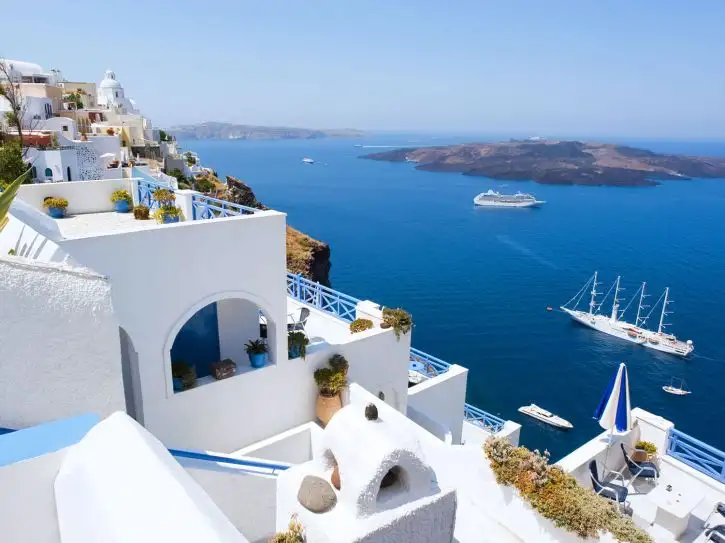
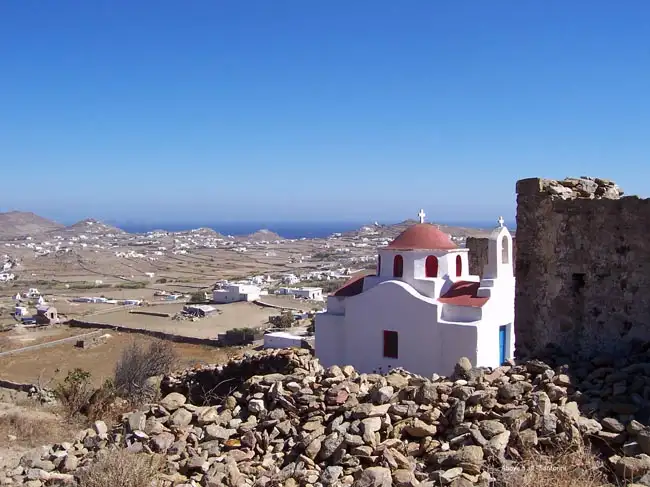
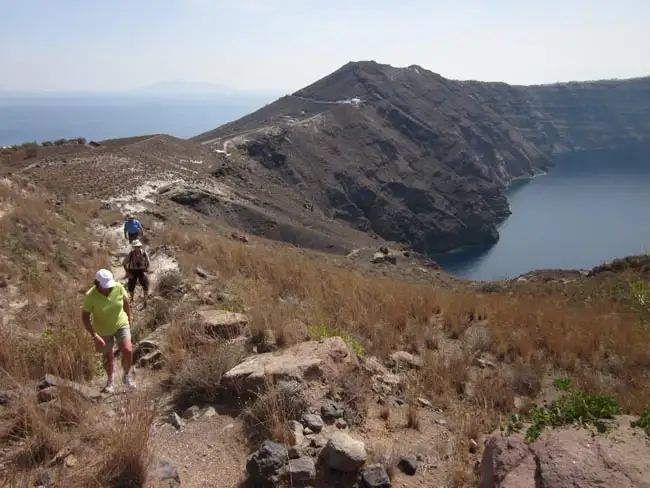
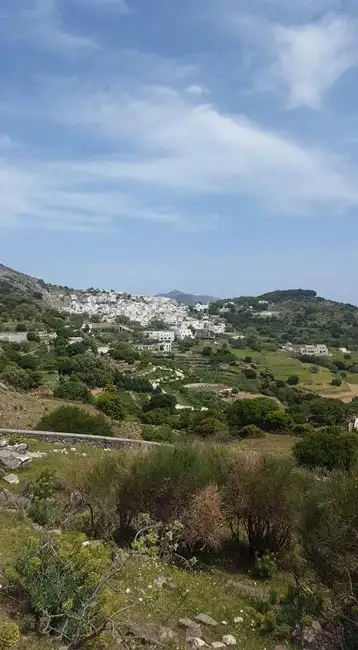
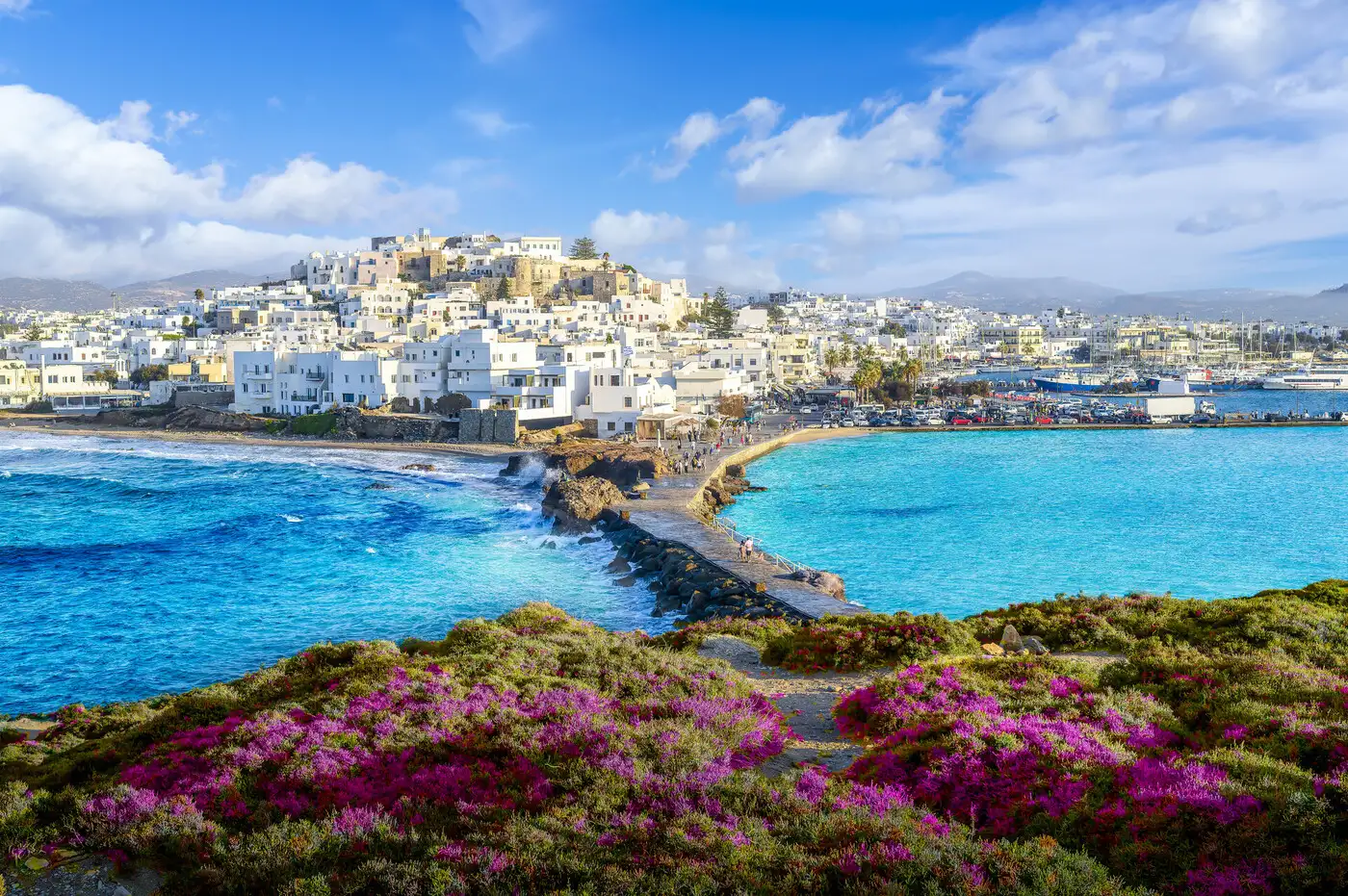
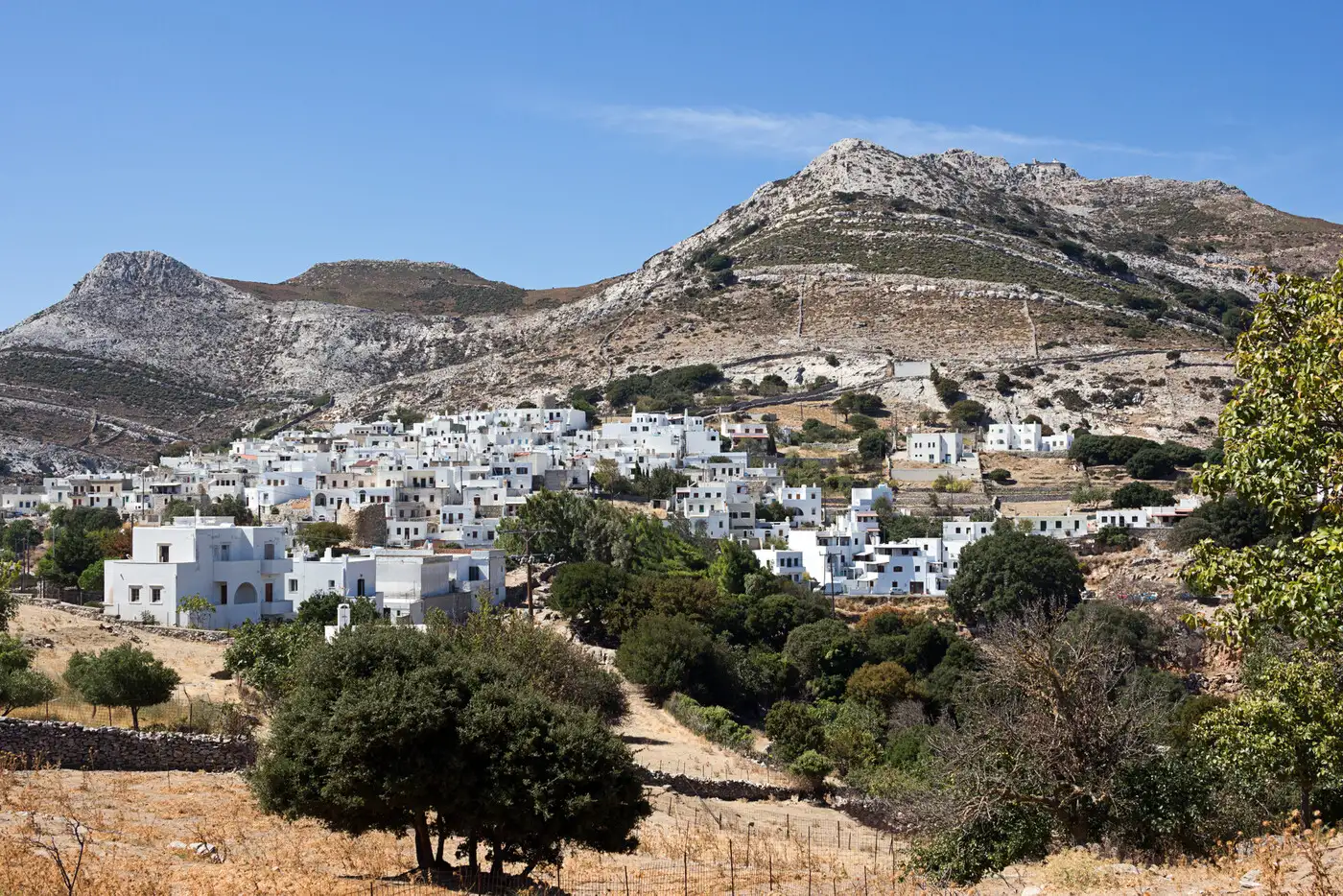



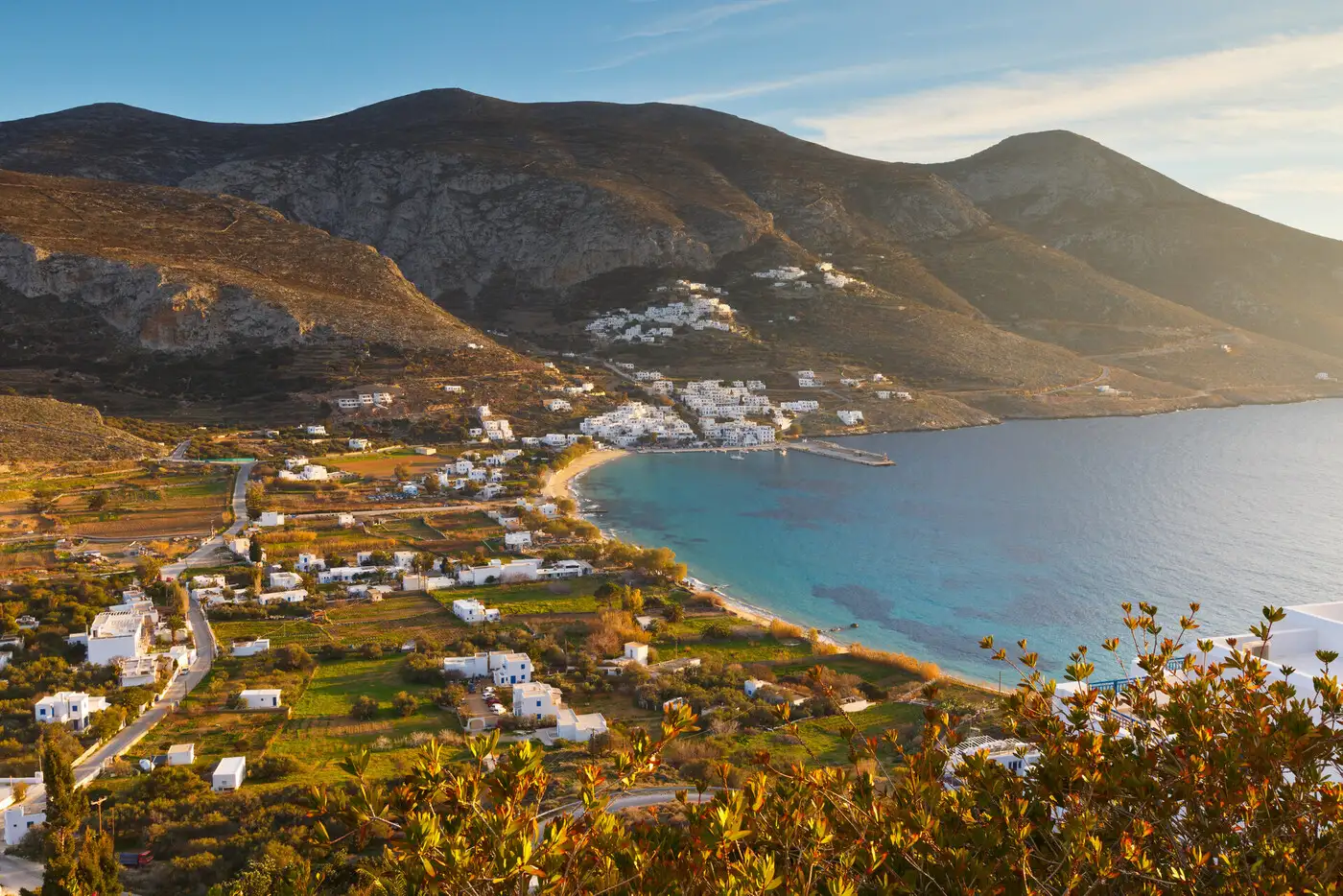
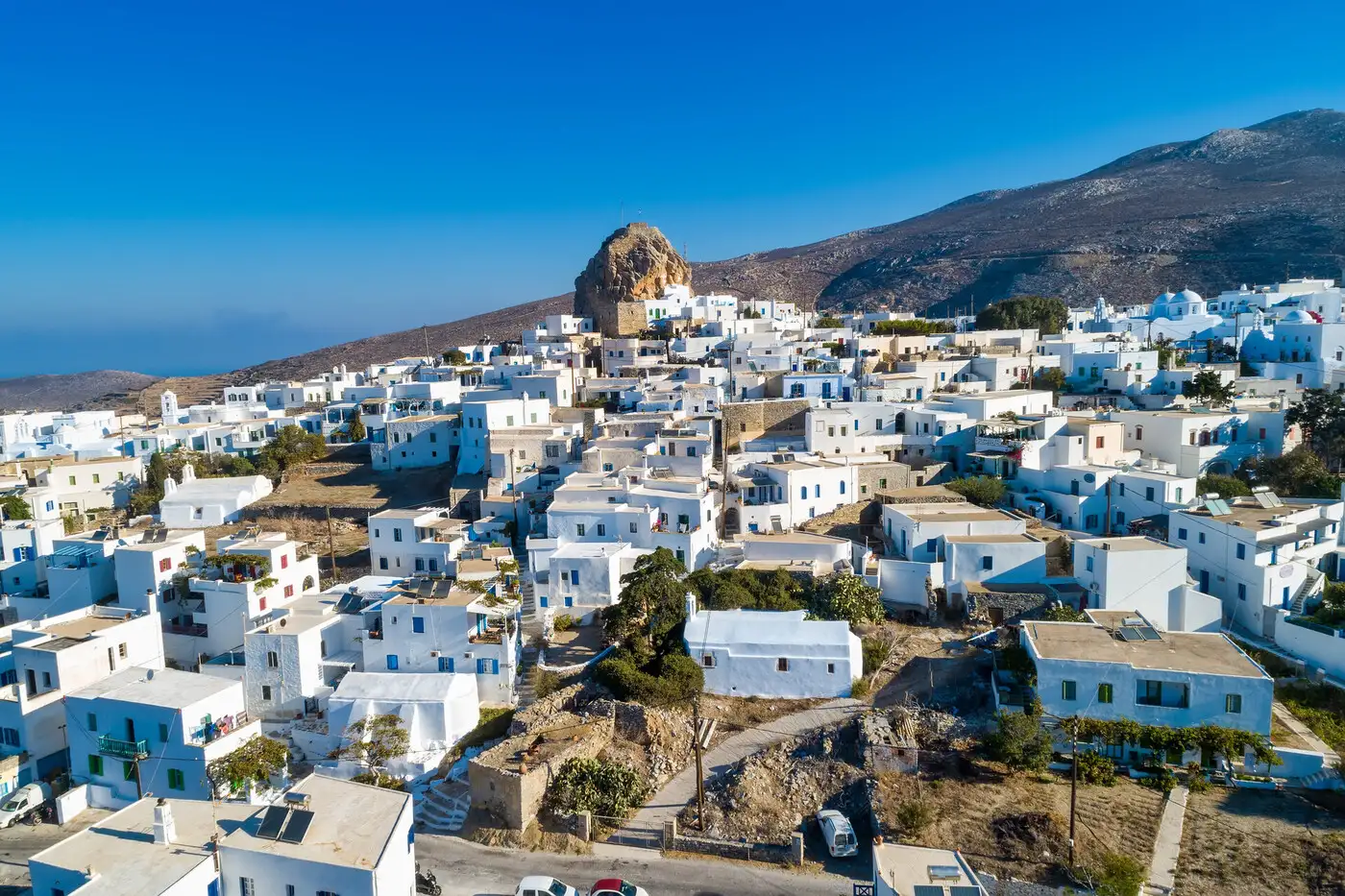



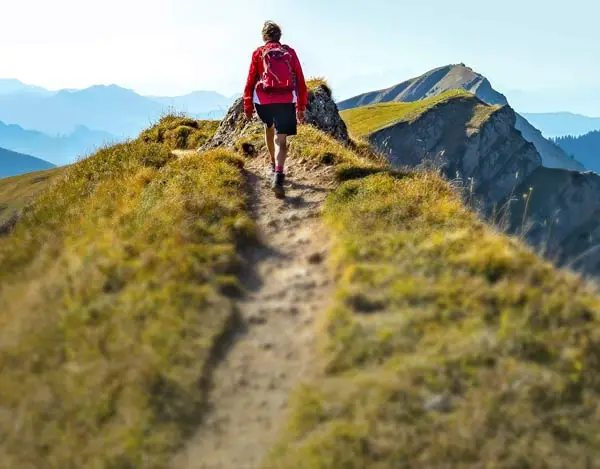
Book This Tour
- Final payment: Due 90 days prior to departure.
- Deposit: A non-refundable $500 USD Deposit is required at booking.
- Optional Single Supplement: $1560 USD (number of singles limited).
(View options forsingle travellers) - Transfering Tour or Date: Transferring to another tour or tour date is only permissible outside of 120 days prior to departure and is subject to a $100 USD change fee.
(Read our cancellation policy)
Prices below are per person, twin-sharing costs in US Dollars (USD). Pricing does not include airfare to/from the tour and any applicable taxes.
Tourcode: GR17
Frequently Asked Questions
- What is the maximum number of participants on a trip?Most of our tours carry a maximum of 18 participants; some tours (ie hiking tours) top out at 16. In the event that we do not achieve our minimum complement by our 90-day deadline, we may offer group members the option of paying a "small-group surcharge" as an alternative to cancellation. If all group members agree, we will confirm the trip at existing numbers; this surcharge is refundable in the event that we ultimately achieve our regular minimum. If the small group surcharge is not accepted, we will offer a refund of your deposit or a different trip of your choice.
- Can I extend my tour either at the beginning or end? What about stopovers?Yes, you can extend your tour either at the beginning or the end and we can book accommodation in our tour hotel. Stopovers are often permitted, depending on air routing. Stopovers usually carry a "stopover" fee levied by the airline.
- How do I make a reservation? How and when do I pay?The easiest way to make a reservation is via our website; during office hours, you are also more than welcome to contact us by telephone.
A non-refundable deposit is payable at the time of booking; if a reservation is made within 90 days, full payment is required. Some trips require a larger deposit. If international airline bookings require a non-refundable payment in order to secure space or the lowest available fare, we will require an increase in deposit equal to the cost of the ticket(s).
Early enrolment is always encouraged as group size is limited and some trips require greater preparation time.
Once we have received your deposit, we will confirm your space and send you a confirmation package containing your trip itinerary, any visa/travel permit related documents, invoice, clothing and equipment recommendations, general information on your destination(s), and forms for you to complete, sign and return to us. Your air e-tickets (if applicable), final hotel list, final trip itinerary, and instructions on how to join your tour, will be sent approximately 2-3 weeks prior to departure. - What about cancellations, refunds, and transfers?Please review our cancellation policy page for details.
- I am a single who prefers my own room. What is a single supplement?All of our tours have a single supplement for those who want to be guaranteed their own room at each location.
This supplement is a reflection of the fact that most hotels around the world do not discount the regular twin-share rate for a room by 50% for only one person occupying a room. Most hotels will give a break on the price, but usually in the range of 25-30% of the twin-share rate. This difference, multiplied by each night, amounts to the single supplement.
The conventional amount can also vary from country to country and some destinations are more expensive than others for single occupancy. In order to be "single friendly," the supplements we apply are not a profit centre for us and we do our best to keep them as reasonable as possible.
On most tours we limit the number of singles available, not to be punitive, but rather because many hotels allow for only a limited number of singles; some smaller hotels at remote locations also have a limited number of single rooms available.
Please note that most single rooms around the world are smaller than twin-share rooms and will likely have only one bed. - Do you have a shared accommodation program?Yes! If you are single traveller and are willing to share, we will do our best to pair you with a same-gender roommate. Please note that should we fail to pair you, we will absorb the single supplement fee and you will default to a single room at no extra charge.
